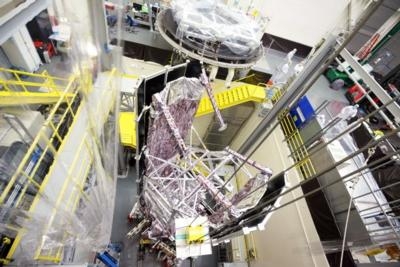Tue, Jun 04, 2019
Spacecraft Element Successfully Endures Extreme Temperatures In Thermal Vacuum
NASA’s James Webb Space Telescope Spacecraft Element (SCE) successfully completed its last environmental test, thermal vacuum testing, at Northrop Grumman Corporation in Redondo Beach, CA.

Thermal vacuum testing exposes Webb’s SCE to the extreme hot and cold temperatures it will experience in space. To test these extreme temperature ranges, the chamber uses liquid nitrogen shrouds and heater panels to expose the SCE to cold temperatures as low as -300 degrees Fahrenheit and hot temperatures as high as 220 degrees Fahrenheit. Real-time data collection via flight sensors on the SCE allow engineers to monitor Webb’s electrical/unit functionality and ensures the structure will withstand the rigors of its cold journey to and operation at the second Lagrange point.
“The world’s largest space telescope has to perform in extreme temperatures,” said Scott Willoughby, vice president and program manager, James Webb Space Telescope, Northrop Grumman. “Successful completion of thermal vacuum testing ensures the SCE can endure the volatile conditions it will face and further validates Webb’s readiness for launch.”
Webb’s SCE completed its two prior environmental tests (acoustic and sine vibration). After thermal vacuum testing, the SCE will return to Northrop Grumman’s clean room to begin post-environmental testing, including deployments. Later this year, the Webb telescope will become a fully integrated observatory for the first time through integration of the SCE to the Optical Telescope Element/Integrated Science Instrument Module.
The James Webb Space Telescope will be the world’s premier space science observatory of the next decade. Webb will solve mysteries in our solar system, look to distant worlds around other stars, and probe the mysterious structures and the origins of our universe. Webb is an international program led by NASA with its partners, the European Space Agency and the Canadian Space Agency.
(Image provided with Northrop Grumman news release)
More News
He Attempted To Restart The Engine Three Times. On The Third Restart Attempt, He Noticed That Flames Were Coming Out From The Right Wing Near The Fuel Cap Analysis: The pilot repor>[...]
Make Sure You NEVER Miss A New Story From Aero-News Network Do you ever feel like you never see posts from a certain person or page on Facebook or Instagram? Here’s how you c>[...]
From 2009 (YouTube Edition): Leading Air Show Performers Give Their Best Advice for Newcomers On December 6th through December 9th, the Paris Las Vegas Hotel hosted over 1,500 air >[...]
Aero Linx: NASA ASRS ASRS captures confidential reports, analyzes the resulting aviation safety data, and disseminates vital information to the aviation community. The ASRS is an i>[...]
“For our inaugural Pylon Racing Seminar in Roswell, we were thrilled to certify 60 pilots across our six closed-course pylon race classes. Not only did this year’s PRS >[...]
 NTSB Final Report: Rutan Long-EZ
NTSB Final Report: Rutan Long-EZ ANN FAQ: Turn On Post Notifications
ANN FAQ: Turn On Post Notifications Classic Aero-TV: ICAS Perspectives - Advice for New Air Show Performers
Classic Aero-TV: ICAS Perspectives - Advice for New Air Show Performers ANN's Daily Aero-Linx (06.28.25)
ANN's Daily Aero-Linx (06.28.25) Aero-News: Quote of the Day (06.28.25)
Aero-News: Quote of the Day (06.28.25)



